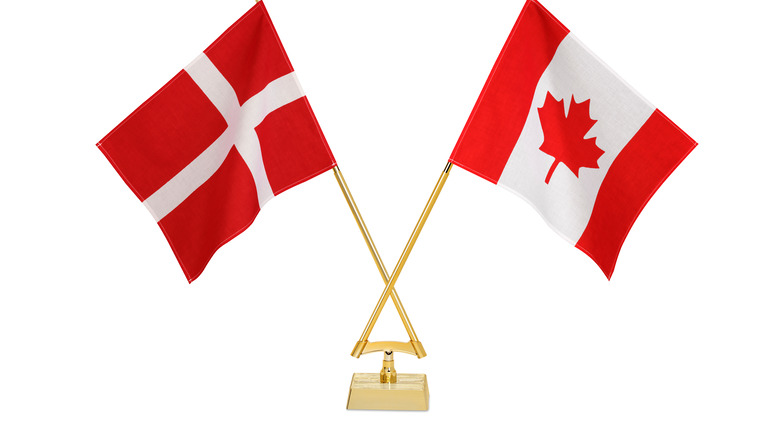The Truth About Canada And Denmark's Fight For Hans Island
Territorial disputes are one of the common and often most brutal causes of international war and conflict, as nations desperate to secure valuable land will send soldiers to fight to the death over it, particularly if it contains important resources or strategic benefits. One of the stranger yet certainly kinder disputes in history, however, has been fought over a tiny, barren island in the middle of the Arctic Ocean. Hans Island, a rock between the coast of Greenland and Ellesmere Island, has been subject to a decades-long conflict between Canada and Denmark, who have traded spirits instead of bullets in what has been dubbed the "Whisky War".
According to Business Insider, Hans Island is half a square mile in size, with no natural resources or strategic advantages or anything remarkable except the fact that it is situated within 12 miles of both Canadian and Danish land. This means that either country has the right to claim it, according to international law. In 1933, it was declared Danish territory by a committee that swiftly dissolved and was replaced by the UN, rendering the ruling invalid.
Canadian and Danish troops exchange alcohol
In 1984, after the land dispute cropped up again following World War II and subsequent conflicts, Canadian troops visiting the island left behind a Canadian flag, a sign reading "Welcome to Canada", and, most importantly, a bottle of Canadian Club whisky. Greenland's minister responded by traveling to the barren rock, removing the Canadian artifacts and leaving behind a bottle of Danish schnaaps and a sign that read "Velkommen til den danske ø," or "Welcome to the Danish island". The Whisky War had begun, and over the years Danish and Canadian troops took turns replacing one country's flag and alcohol with their own, per Business Insider.
Not everyone in the two countries' governments were so pleased with the polite dispute over Hans Island, known as Tartupaluk in Greenlandic (via Arctic Today). In 2005, government officials began an effort to truly resolve the island's fate by requesting a geological survey and, if necessary, appear before an international court. In 2016, scholars on both sides suggested the island should be shared, split down the middle to create an unlikely land border between two nations separated by the Atlantic. Two years later, a Joint Task Force was created to resolve boundary disputes in the Arctic, including the now-famous one on Hans Island. The issue has yet to be completely resolved today, and the world's most polite war rages on.

